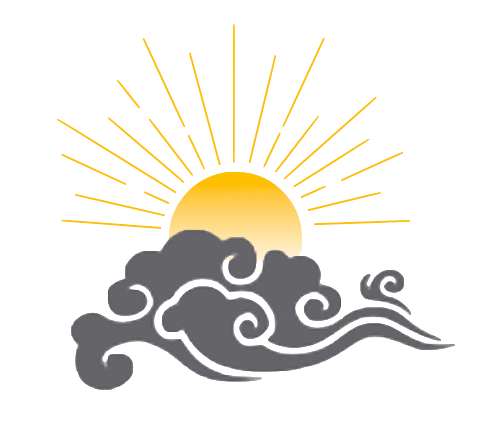Zheng Qinan: Exposition on the Nature of ‘Shanghan’
Qing dynasty master physician, Zheng Qinan
From Zheng Qinan's 医法圆通 Integrated Mastery of Medical Strategies, chapter entitled 伤寒溯源解 Exposition on the Nature of 'Shanghan'
Note: The two characters 伤寒 from the title of the classic work by Zhang Zhongjing can be literally translated as "damage” or “injury" and "cold", a concept that Zheng Qinan broadens to explain the physiological breakdown in energy flow through the invasion of a pathogenic factor, as we will see below. This is radically different from the way it is commonly rendered in English as simply referring to the resulting "febrile disease".
仲景为医林之祖,著《伤寒》一书,以开波世津梁,提出三阳三阴,包含乾坤二气之妙,后贤始有步趋。注家日多,纷纷聚讼,舍本逐末,以至于今,故读《伤寒》书 者寡矣,亦并不知伤寒何所取义也。即注伤寒者,亦只是照原文敷衍几句,并未道及伤寒宗旨,与万病不出伤寒宗旨,教后人何由得入仲景之门,余特直解之。夫曰 伤寒者,邪伤于寒水之经也,太阳为三阳三阴之首,居于寒水之地,其卦为坎,坎中一阳,即人身立极真种子,至尊无二,故称之曰太阳,如天之日 也。太阳从水中而出,子时一阳发动,真机运行,自下而上,自内而外,散水精之气于周身,无时无刻无息不运行也。故《经》云:"膀胱者州都之官,津液藏焉, 气化则能出焉。"气化二字,乃伤寒书一部的真机。要知气化行于外,从皮肤毛窍而出水气,气化行于内,从溺管而出水气。外出者,轻清之气,如天之雾露也;内 出者,重浊之气,如沟渠之流水也。
太阳之气化无乘,一切外邪,无由得入,太阳之气化偶衰,无论何节何侯中不正之气干之,必先从毛窍而 入,闭其太阳运行外出之气机,而太阳之经证即作,故曰伤寒。今人只知冬月为伤寒,不知一年三百六十日,日日皆有伤寒。太阳为六经之首,初为外邪所侵,邪尚 未盛,正未大衰,此际但能按定太阳经旋治,邪可立去,正可立复。因近来不按经旋治,用药不当,邪不即去,正气日衰,邪气日盛,势必渐渐入内,故有传经不传 腑,传腑不传经,二阳并病,三阳并病,两感为病,渐入厥阴,邪苟未罢,又复传至太阳,迁延日久,变证百出,邪盛正衰,酿成阴阳脱绝,种种危候,仲景立三百 九十七法,一百一十三方,以匡其失,而扶其正。
As one of the founding fathers of Chinese medicine, Zhang Zhongjing authored the Shanghan Lun as a tool for the clinical treatment of human afflictions. He outlined the three yang-three yin phase system of diagnosis, representing the subtleties of qian (Heaven) and kun (Earth) so that generations of physicians to come might deepen their understanding of medicine. Over time, there have been many commentaries, all with different opinions that argue over key points of the original text. The overall result has been to branch out away from its original meaning, so that now there are few people who even bother to read the Shanghan Lun, and those that do, are confounded as to how to understand its true meaning. In their perfunctory work on the text itself, these commentators have failed to grasp the deeper essence of the Shanghan Lun, which extends to all forms of disease. How, then, can those who come after gain access to the genius of Zhang Zhongjing? I shall explain here in no uncertain terms.
The concept of shanghan begins with the introduction of a pathogen to the meridian of cold water. The Taiyang channel lies at the head of the three yang and three yin phases, and is the domain of cold water. Its associated trigram is kǎn (water), whose single yang element is the primary source of all human life. In this, it resembles the awesome life-giving power of the sun and is thus referred to as Taiyang. The sun rises out of the water and during the zǐ period (11pm-1am), this single yang element comes to life and the dynamics of the qi mechanism begin moving upward and outward. it spreads water and essence to the surface of the body, constantly moving without rest. The Neijing states, "The bladder is the official of the central capital, fluids are stored there and emerge with qi transformation." This process of qi transformation lies at the heart of the Shanghan Lun. One must be familiar with the process of qi transformation in the surface of the body, where water vapor is expelled from the skin and pores and with qi transformation in the interior of the body, where water is expelled through the urinary ducts. Vapor at the surface of the body is light, arid qi, much like mist or fog; water expelled from within the body is heavy and turbid, much like the flow of a drainage stream.
If the qi transformation of the Taiyang channel remains unimpaired, then there are no avenues through which pathogenic qi may enter the body. When Taiyang qi transformation is weakened, no matter what the season or time of day, pathogenic qi will invade. It must first enter through the pores and block the expulsion process of Taiyang qi transformation. This leads to the development of a Taiyang channel condition, thus, referred to as 'shanghan'. Practitioners today believe that “cold damage” is limited to only the winter months; they do not realize that it can occur at any time throughout the year. The Taiyang phase is the first of the six phases to be afflicted by cold damage. At this stage, the pathogen is still relatively weak and the vital qi (zheng qi) is still very strong. If the practitioner is able to correctly diagnose and provide treatment according to the Taiyang condition, the pathogen can be immediately dispelled and zheng qi can immediately recover. However, because people no longer practice this system of six phase diagnosis, they use herbs incorrectly and the pathogen is not dispelled, thus further weakening zheng qi and increasing the strength of the pathogen. The illness will gradually grow deeper. Some transform via the channels and not the fu organs, while others via the fu organs and not the channels; others lead to a concurrent condition of two yang phases, some to a concurrent condition of three yang phases, while others directly strike two phases. Eventually, the pathogenic qi reaches the Jueyin phase with its roots still intact, it reemerges into the Taiyang and slowly over time develops into various diseases. In the end, this leads to the separation of yin and yang in the form of a life-threatening condition. Therefore, Zhang Zhongjing established the 397 methods and 113 prescriptions of the Shanghan Lun in order to dispel pathogens and tonify zheng qi.

